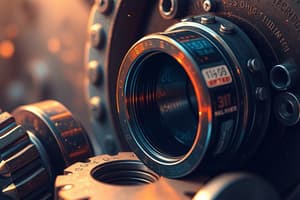Podcast
Questions and Answers
What is the purpose of screws?
What is the purpose of screws?
- To hold parts together
- To apply pressure on an object
- To adjust parts with respect to each other
- All of the above (correct)
Define 'Helix'.
Define 'Helix'.
The spiral grooves cut into the surface of cylinders.
What are 'External' threads?
What are 'External' threads?
Threads found on a bolt, cap screw, wood screw, etc.
What are 'Internal' threads?
What are 'Internal' threads?
What is 'Major Diameter'?
What is 'Major Diameter'?
What is 'Minor Diameter'?
What is 'Minor Diameter'?
Define 'Pitch'.
Define 'Pitch'.
What is 'Lead' in the context of threads?
What is 'Lead' in the context of threads?
What are the four standardized classes of fit?
What are the four standardized classes of fit?
What degree is the angle created by the slope of a standard thread?
What degree is the angle created by the slope of a standard thread?
What is a tap used for?
What is a tap used for?
Which type of threads allows for rapid advancement of parts?
Which type of threads allows for rapid advancement of parts?
What is 'Class of Fit'?
What is 'Class of Fit'?
Match the following thread types with their characteristics:
Match the following thread types with their characteristics:
Flashcards are hidden until you start studying
Study Notes
Purpose of Fasteners
- Screw threads hold parts together using bolts or screws.
- Adjust parts relative to each other, as seen with adjusting screws in drafting tools.
- Apply pressure to secure objects in place using setscrews.
Types of Threads
- Helix: Spiral grooves on cylindrical surfaces.
- External Threads: Located on bolts, cap screws, and wood screws.
- Internal Threads: Found on nuts or tapped inside components.
Thread Measurements
- Major Diameter: Largest diameter measured from crest to crest.
- Minor Diameter: Smallest diameter of a thread.
- Crest: Shallowest part of the thread.
- Root: Deepest part of the thread.
- Pitch: Distance between corresponding points on adjacent threads, typically in threads per inch.
- Lead: Distance a thread travels with one complete revolution.
Thread Configurations
- Single Threads: Lead equals pitch.
- Multiple Threads: Lead exceeds one pitch, allowing quicker advancement (e.g., double threads move twice as far).
Fit Classes
- Class 1: Loose fit for rough work.
- Class 2: Free fit for general purposes.
- Class 3: Medium fit for higher quality applications, like automotive use.
- Class 4: Close fit for tight applications, as in aircraft engines.
Thread Characteristics
- Thread Depth: Measurement from crest to root.
- Thread Angle: Angle between the thread walls.
- Standard Thread Angle: Typically 60 degrees.
Thread Direction
- Right-Handed Threads: Advance clockwise; presumed if not specified.
- Left-Handed Threads: Advance counterclockwise.
Tools for Threading
- Tap: Tool for creating internal threads.
- Small Threads: Often cut by hand.
- Large Threads: Typically cut using a lathe.
- Die: Tool for forming external threads.
Thread Standards
- ANSI: American National Standard for Unified Threads.
- Unified National Coarse (UNC): Most common thread series.
- Unified National Fine (UNF): Stronger than UNC, providing secure fastening.
- Unified National Extra Fine (UNEF): Highest tensile strength, suitable for high vibration applications.
- Metric Thread: International standard based on ISO.
Specialized Threads
- Square Thread: Transmits motion or power, challenging to manufacture due to perpendicular sides.
- ACME Thread: Easier to manufacture with a 60-degree angle, used for rapid screw actions.
- Sharp-V Thread: Provides friction holding; commonly used in brass components.
- Knuckle Thread: Common on products like light bulbs and screw-type bottle tops.
Studying That Suits You
Use AI to generate personalized quizzes and flashcards to suit your learning preferences.




